






|
2008 |
 |
 |
 |
 |
 |
 |
 |
|
Picture of the Week (December 29): A mysterious stranger at the Maryland Renaissance Festival in Crownsville last August. (Really, this is Agnieszka, my wife.) Camera: Olympus E-510 Lens: 70-300 mm F/4.0-5.6 ZD at 76 mm Exposure: Aperture priority (-0.3 EV); 1/500 s at F/5.6, ISO 400, sunny WB. Postprocessing in Corel Photo-Paint. (Click on the picture to see it in higher resolution.) |
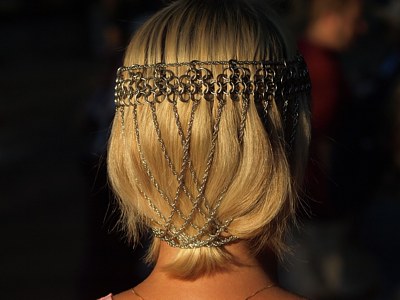
|
|
I am in Poland now, enjoying the Christmas and New Year season here, meeting family and old friends, eating, drinking, and catching up with sleep. That's as good as it gets, a welcome reprieve from the daily rat race in suburban Maryland, especially in the recent months. Just yesterday a friend decided to get himself a belated Christmas present; walked into a local photo outlet, tried the Nikon D90 and the E-520, and chose the latter, a decision based mostly on the physical feel of the camera in his hands. Only then did he call me from the store to have his choice approved. Another friend is already lining up to get the E-30 as soon as it becomes available, to complement his 7-14 mm Zuiko Digital. This and other anecdotal evidence suggests that Olympus SLRs are more popular in Poland, compared to other brands, than in the States. Perhaps the bang-for-the-złoty factor? The E-30: expectations vs. reality. Last March I wrote a small article for the Olympus Circle Quest newsletter in the UK, outlining my expectations from the possibly upcoming Olympus mid-line SLR model. Frankly, I forgot about it since. Now the article has been posted at this site, and the bottom line is that the new camera has almost exactly the specs I hoped it to have — except, perhaps, some unique feature to make it stand out from other makers' models, crowding this market segment. In a few hours I'm taking off for Poland; back in the States on January 4. Merry Christmas and Happy New Year, everybody! So, what was happening while I was out of circulation (very much up to yesterday, inclusive)? Well, not much, but at least two developments attracted my attention. The Micro Four Thirds standard, announced jointly by Olympus and Panasonic, promises to bring lens interoperability between non-SLR cameras by various manufacturers. The standard defines the sensor size (same as in Four Thirds: 13×17.3 mm) and lens mount interface (both mechanical and electronic). The sensor size, while close to that commonly used in most digital SLRs, is well above that common in non-SLRs (I mean: EVF models): there is a factor of about 2.3× (linear) or 5.1× (area) when compared to the popular 1/1.7" sensor size used in better EVF cameras (some use even smaller sensors). Because the standard aims at cameras without the swinging mirror in front of the sensor, the distance from the lens mount to the latter can be smaller than in the "regular" Four Thirds, and so (if not for these reasons) can be the diameter of the lens mount. This should lead to a line of EVF camera models smaller then the current Four Thirds SLRs, but providing a performance superior to that of the small-sensor EVFs. This may sound attractive, but I am not so sure. Technical considerations aside, all depends on what cameras will now follow. |
|
At this moment only Panasonic has a model out, the very capable G1 (full name: Lumix DMC-G1), with clearly the best electronic (SLR-like) viewfinder in the industry. I really like the controls (levers below dials) and the finder looks really good, but I'm still not quite convinced. Certainly, I dislike the fact that Panasonic decided to go with their own in-lens image stabilization system; this reduces the lens interoperability.
Then, the G1 is not that much smaller than the Olympus E-420 (but it has a swiveling screen). Oh, well, this is the first attempt, and I will not criticize a camera I haven't tried (although my criticism on image stabilization remains valid). |
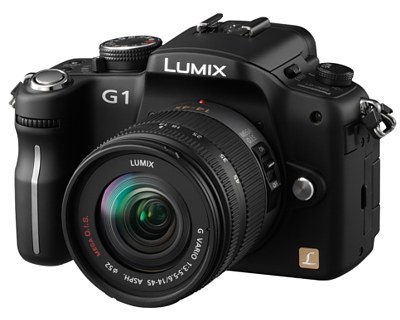
|
|
Olympus has shown a Micro Four Thirds camera mock-up of an entirely different breed: brick-shaped, no viewfinder at all, except for the LCD screen. It is tiny and elegant, but not serious at all. Maybe as a last-chance backup to your SLR? Because, yes, the new standard will allow for use of the "regular" Four Thirds lenses, with an adapter. Not without caveats, though: most of the Olympus lenses in that standard do not provide contrast-detection autofocus used by the μFT cameras. Only the most recent ones (just five models, I believe, as of today) do. So OK, your older lenses are fine, but in manual focus only, hardly a thrill. These are just my initial thoughts; I still have to do more research and thinking on this subject; more should follow when I know what to say. Still, this may be the beginning of the dawn of the SLR era, as predicted in my Quest article of 2005: [The] EVF-based cameras may soon provide, arguably, the best of both worlds: real-time viewing of a quality comparable with today's SLRs, with less mechanical complexity and at a lower cost. [...] EVF cameras may [...] soon dominate the middle segment of the market (advanced amateur), with SLRs withdrawing to the higher ground [...] As much as I would hate to see this happen, this may be what is really coming next. We can run, but we can't hide... A mid-line Olympus SLR has been announced, at long last. Olympus decided to name it E-30, like to stress that it has nothing in common with the E-10 and E-20 from a few years ago. Do I sound sarcastic? Maybe, but that's on purpose. The E-30 should become available some time in January, but the specs are already well-known. The camera looks like an E-3 on a (mild) diet; gone is the magnesium alloy body and weatherproofing, but the E-30 retains all that was good in its predecessor, and throws in a few improvements (and I do not mean just raising the pixel count). | |
|
Generally, I like the E-30 a lot, and I'm thinking of getting one as soon as it becomes available — unless I discover something really horrid about it in the meantime.
I'm glad I did not fall to the temptation of the E-520 which, after all, is almost the same as my trusty E-510 (which has proven itself again very nicely in the Arizona desert this October). Anyway, whatever information I could find out about the E-30 at the moment, plus my usual comments on what is good and what could be improved, can be found in Olympus E-30: Just a cheaper, smaller, lighter E-3?. As soon as I get this camera in January, I'll start on a full review, detailed and nitpicking as usual. |
.t.jpg)
|
|
Three months ago I disappeared below the radar. This was just a necessity: my professional work had to take precedence, and there was more of it than I could handle (I did, though). I was touched by those of the Readers who worried about my well-being, and asked if I am fine. Thank you for caring. Yes, I am, just busy, but things are looking better now. Now, with the work pile-up gone, I will be emerging (slowly) from the backlog of email, also neglected during that time. I'm starting from a vacation trip to southern Arizona, originally planned for May or June, and then postponed multiple times. When back after October 22, things should be back to usual at this site — this is an activity I enjoy a lot, and I am not even considering giving it up. Until then... | |
|
Picture of the Week (June 30): This guy checks my patio every half hour or so. When I work on my laptop, on the carpet next to the patio door, I keep a camera at hand, just in case. All it takes is peanuts. And yes, I really like this lens! Camera: Olympus E-510 Lens: 70-300 mm F/4.0-5.6 ZD at 300 mm Exposure: Aperture priority (-0.7 EV); 1/180 s at F/8, ISO 400. Postprocessing in Photo-Paint: very slight crop, some tonal adjustment and sharpening. (Click on the picture to see it in higher resolution.) |
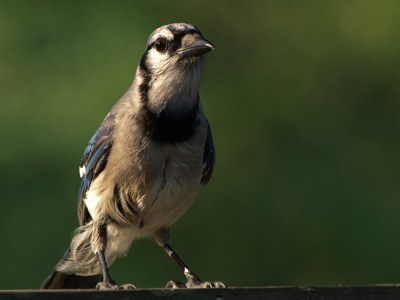
|
|
The new Olympus E-420 is already selling in the States, and its non-identical twin, the E-520 will be on store shelves any day now. I compiled the available information in an article discussing these two: The Generation of 2008. The article focuses mainly on differences between both models, and the changes from the last year's Class of 2007 (E-410 and E-510). After having used the 50-500 mm Sigma lens for over a month, I can say I'm not thrilled with it. Yes, it can deliver reasonably sharp images (tripod or not), but the resolution isn't that great, and AF problems do not help. I prefer the "budget" 70-300 mm ZD at less than half the price (and at third of the weight). Yes, it has less reach, but it works just fine with the EC-14 (1.4×) teleconverter, bringing the long end to 420 mm at F/8, with better (!) autofocus and at least the same effective resolution. (Additionally, I can use the EC-14 with my 50 mm F/2.0 ZD, getting a nice 70 mm F/2.8.) The Bigma write-up is still waiting for inclusion and discussion of my image samples. My desktop computer, which I use to store and process photographs, just died last Friday when the power line was hit by a lightning. While I hope to recover the contents of the hard drive, I'm quite happy that all back-ups on an external USB drive (more exactly, two such drives; I'm not taking any chances!) were up-to-date. Accidentally, just a few days earlier I ordered a new, quad-core desktop, so no real harm is done at all. Now, stop reading this and update your backups... |
|
A recent Olympus announcement included, in addition to the new E-520 (see below), a new lens: the 9-18 mm F/4.0-5.6 ZD wide-angle. This is a significant development, as with this lens Olympus has the whole 9-300 mm (18-300 mm EFL) range covered with their "economy" lens line. (The previously announced Sigma 10-20 mm also became a reality recently.) | |
|
The basic specs of the new lens can be found in my updated Four Thirds lens list. While I do not expect it to compete optically with the outstanding 7-14 mm ZD, I hope for its performance to be as good as that of the 70-300 mm ZD — good enough for most of my applications, while selling for much less. The lens should become available in September, and then we will see if my hopes were justified. True, I would prefer this lens to start from 8 mm, but 9 mm (18 mm EFL) is nothing to sniff at: on 35-mm film the 20 mm focal length was my favorite for close-quarters architecture shots, and every extra millimeter (2 mm EFL!) adds cost, size, and complexity. Count me first in line to get this lens when it becomes available. |
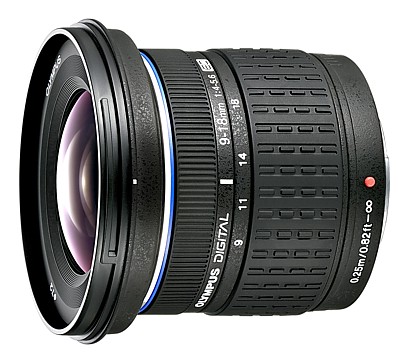 (Promotional picture by Olympus) |
|
For the last few days I'm receiving one or two emails a day, asking for help in choosing between the new model and the "old" E-510, so here it is, as subjective as it may be: if the new model is within $150 or so from the old one (which may drop in price now), go for it; otherwise get the E-510. | |
|
Last Saturday a friend loaned me a Sigma 50-500 mm F/4.0-6.3 DG lens, affectionately referred to as the Bigma. (This means my write-up in progress should get out of the limbo state quite soon.) As soon as we left home to try the Bigma out on Sunday morning, my wife spotted this green heron on a tree just twelve yards from our doorstep.
The bird was quite co-operative, listening to a teenager on the lake shore below, who was playing some old Stones songs on his ukulele (I'm not inventing this!), so I was able to squeeze out a few dozen of frames; this is the very first one. |
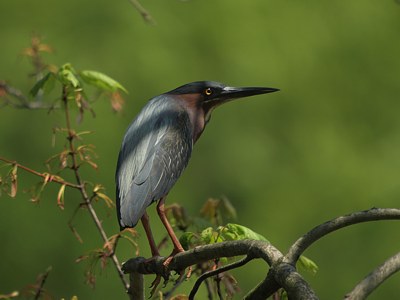
Olympus E-510, Sigma 50-500 mm F/4.0-6.3 ED at 500 mm; aperture priority (-0.3 EV): 1/800 s at F/6.s, ISO 400, WB at 5300°K. Postprocessed in Photo-Paint. |
|
The Bigma (or any other lens of this focal length) is not for everyone: large and heavy, with a razor-thin depth of field at the long end, prone to camera shake; you really have to watch what you are doing. Still, it has the reach (1000 mm on a 35-mm film camera), and it can reward the effort. Out of fifty or so pictures shot in that session, about forty were sharp enough — and that's without image stabilization, which I just forgot to turn on. In the coming days I will learn more about this lens by using it, mostly for wildlife shooting. In the meantime, however, my User Report on the 70-300 mm ED ZD is ready, with lots of image samples; have a look if you are interested in these focal lengths. | |
|
My E-500IR has arrived. The infrared response and tonality are as expected: just excellent; the bad news is that the autofocus is way, way off with all lenses I've tried (I'm working on that now). My first impressions, findings, and samples can be found in the updated article. Olympus E-500IR (IR modification by LDP), 14-45 mm F/3.5-5.6 at 14 mm. Aperture priority (-0.3 EV): 1/250 s at F/9.0, ISO 100. Postprocessed in Photo-Paint. |
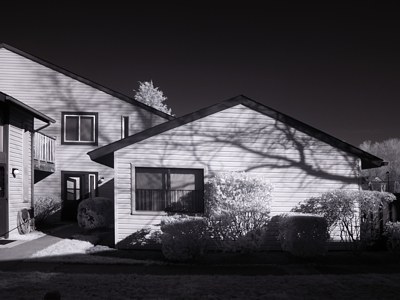
|
|
Back in the States, back home. And my E-500IR should arrive within two days or so; I'm very excited to put it to use and to see how digital IR photography looks with no ifs and buts. The trip to Poland was slow, lazy, and most enjoyable. I've got some nice pictures of my old hometown of Łódź, to be shared with you next week or so. The camera — or the person behind it? Many say that the latter is the limiting factor in pictures; now a major camera manufacturer seems to have understood that. Here is the exclusive full story on the Lumix FRT-1 by Panasonic, a camera which will make you a better photographer. It's this time of the year again. In a few hours I'll be taking Amtrak from BWI to Newark, NJ, for a red-eye flight to Warsaw, Poland. Back in Maryland next weekend, but in the meantime my email may get a bit clogged. The E-500IR story: the first installment is out. I still have to send out the camera to LDP, which will be in the first days of April; then I will keep you updated. I just bought a Panasonic FZ-18 for a friend in Poland. The poor man stubbornly insisted on a super-zoom camera, and no amount of persuasion would deter him (and believe me, I tried). After a few days with it, I stick to my guns. While this seems to be the best model in that class, the class itself stinks to heavens — from almost every angle. While I wasn't thrilled with the lamented Olympus C-8080Z, that is still a camera to match in the EVF category. And, yes, my five-years old C-5050Z runs circles around the FZ-18 in terms of image quality. For a while I was thinking about writing a small review of this camera, but this is not worth the effort. Too much time which I can spend doing other stuff. Windows Vista got a facelift: Service Pack 1, released last Monday. I just installed it; the good news is that the upgrade does not reset all the tweaks I had to introduce to make this OS usable. So far so good; for the last two months I was running SP1 Beta anyway. No, no surprises; this is still Vista. I have also got the MS Internet Explorer 8, beta version. While I use Opera as my working browser, I always check how my Web pages are rendered on the MSIE (and on the Firefox). It took me 20 minutes to confirm that some old bugs (or "non-standard features") sill persist in the Explorer 8, with all the hoopla Microsoft is making about following the standards. For example, the bug causing my and icons to be rendered in a wrong place when the link text spans two lines, is still there. No, I'm not going to work around this particular problem (and there is no simple work-around except for inserting the images by hand in all places). If you want to see these pages the right way, just get a real browser. Happy Easter, everyone! More on infrared: lots of activity here. First, a posting of my December Quest article: Digital Infrared; waiting for a B&W IR camera. Well, even with the new Fuji IS Pro and IS-1 the wait is not quite over until someone gets rid of the Bayer mosaic; read the article for more. Second, I have collected the results of my research and deliberations on infrared SLR modifications into a new article: Digital SLRs for Infrared Photography. This is, in a sense, a follow-up to the other article, and it may be educational, even if you are not planning to convert one of your cameras (not yet). Third, Mr. Dan Llevellyn of LDP (or MaxMax.com) kindly answered some of my questions regarding IR modifications of Olympus SLRs. Yes, they do the E-500 and E-510; no, they do not do the E-330; and, regretfully, no word on other models, including the E-1 and E-300. I have already decided to give my E-500 a second career as an IR-only camera, and I will send it to LDP as soon as I'm back from my Easter break in Poland. Then I will keep you updated. Site cleanup. From time to time I receive emails from those who would like to view this site in larger fonts. Or in smaller fonts. Or in sans-serif. Obviously, with various display sizes, operating systems, local font size settings, and Web browsers out there, not to mention personal preferences, it is difficult to please all. Not really. I just wrote a short script detecting your browser window size and adjusting the font accordingly. This should work for most users, as larger screens usually need larger fonts. Also, in small sizes sans-serifs tend to be more readable, while the opposite holds at larger ones, so this is also accounted for. To give you an extra choice, I'm also providing a small page for font setting, accessible by the site map at the bottom of every page. From there you can tweak the settings yourself. For that to work, your browser must run JavaScript (not Java!) and accept cookies from the wrotniak.net domain. This is an exception I had to make to my no-cookie policy, as the task is impossible without cookies providing persistency of settings. Once set, your preferences will be remembered on a given computer and browser, and used every time you visit here. I hope you will find this useful. In another refinement, many manufacturer's product shots in various articles have been replaced with those of better quality, usually linking to larger versions, like this one. Having a free weekend (no more E-3 this week, this can wait!), I decided to try the new Version X4 (this is 14, for sane people) of Corel Photo-Paint, the program with which I have a long love-and-hate relationship. This needs some challenge, so I chose to postprocess the oldest digitized photographs in my archives: those shot back in 1970 in Moscow (my first trip out of Poland, first flight, and first encounter with the Evil Empire). | |
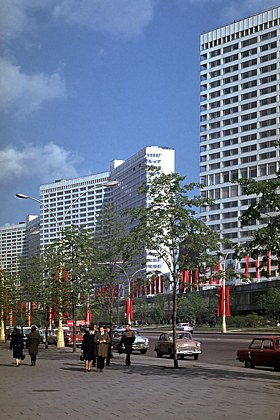
|
These were shot with the Soviet Start SLR, a workhorse of a camera (still working!) on the East-German ORWO slide film, home-processed. In 1995 the slides were badly faded, so I had them scanned to the Kodak Photo CD (six megapixels); then for another thirteen years the CDs were gathering dust. To give you an idea of the challenge, here is a Photo CD scan, converted into a JPEG, downsized, and slightly re-sharpened. Click at the image on the left to see the final result, in the same pixel size. Not too shabby. Surprisingly, the Image Adjustment Lab, a feature I never use with my digital-camera images, performed nicely in this application. In most cases, Auto Adjust would bring the image to a decent shape, needing only minor tonality and color adjustments (on the other hand, with other slides from the same era, the results were very bad). The grain in the ISO 64 film was horrendous, especially in sky areas. ISO 800 on my E-510 (or ISO 1600 on the E-3) is way better; just no contest. In all frames I had to resort to the Neat Image plugin, which has proven itself quite well. But the most time-consuming task was removing hundreds of dark specks — maybe dust stuck to emulsion, maybe impurities in tap water used to prepare the chemicals. |
|
The bottom line: while I wouldn't dare to print the results at 10×15" or larger, they can be quite presentable at 8×12" or less; a result worth the effort. If you have some memories stored on a Kodachrome (or, especially, Ektachrome) film, do not delay, have them scanned now. In a few years it may be too late. Some results of this session can be found in my Moscow Gallery; I hope you will enjoy this trip in space and time. And what about the new version of the Photo-Paint, you will ask? Well, there are very few changes from the previous Version X3, for most users not justifying the $200 upgrade price. Some minor features have been added; some minor bugs fixed; many small but irritating bugs and inconsistencies still remain, unchanged since at least Version 9. Generally, the program performs well; as much as I complain about it, I still have to find something better for my needs (yes, I've tried them all, including the latest Picture Window). The most irritating thing about Photo-Paint is how Corel sells it: only as a part of the $400 Corel Draw suite, take it or leave it. No wonder most photographers choose the latter option, having no use for Corel Draw itself or Corel Trace. I am not surprised seeing no other Photo-Paint users among fellow photographers: after all, Corel does everything to keep the program from selling. And this the thing they do best. | |
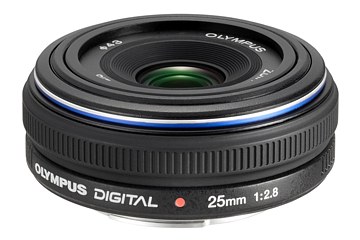
(Image © by Olympus) |
In a quite unexpected development, Olympus also announced a new lens: the compact 25 mm F/2.8 ZD, measuring only 24 mm in length. This lens did not figure in the Olympus lens roadmap. (See my lens chart for details.)
The lens brochure says it is "meticulously crafted from aspherical glass". Whoever writes things like that should be sent for two months to clean the toilets at Olympus optical facilities, just to get more familiarity with the subject. |
|
The camera is expected to become available in May at a street price of $500 (body), $600 (with the 14-42 mm F/3.5-5.6 ZD) or $700 (with the new 25 mm lens). Digital Camera Resource posted the full press release with extra illustrations, and the E-410 Preview at Imaging Resource contains quite a detailed description (seemingly based on Olympus promotional materials, not a pre-production camera). Last but not least, Popular Photography posted a small Hands-On Report, too. You may also browse the E-420 section of the Olympus site. News from this site: my User Report on the 12-60 mm F/2.8-4.0 ZD zoom is out. It is among lenses what my wife is among women: as close to perfect as they come. Read the full text for more (about the lens, that is). | |
|
The traffic here increased in the last month: from about 2400 unique visitors a day in January (typical for the past year), to 3600 per day in February. This may be related to the recent articles concerning the Olympus E-3. Luckily, the good people at PowWeb (who are hosting this domain) have increased my bandwidth allocation (and storage, too) to more than I can ever use, without even telling me. A nice surprise. This is a good hosting company: I send them a check once a year and that's the whole interaction we have: things just keep working. Do not feel guilty downloading all those full-size samples; all this site costs me is less than a dinner for two: $93.24 each year. Plus time. Another E-3 installment: E-3 Image Samples, Part 2. Most of these were shot under overcast weather. The next thing in line will be comparison of colors at various WB and saturation settings, coming in a week or so. On image stabilization: your camera proudly sports an IS sticker (things without a sticker do not count). You are getting pictures without blur at 1/40 s with a 50 mm lens. Well, that's a 100 mm "equivalent", therefore IS brings a 2.5× improvement, not bad! Then you notice that you forgot to turn image stabilization on. Oops. Looks like the factor of 2.5× is the magic effect of the sticker alone... Maybe I should patent that. For the time being, I've put a note on this into the E-3 IS article. (2009: The note has ben moved here.)
E-500IR? I'm considering a conversion of my E-500 (not used much now, anyway) into an infrared-only camera, with the a dramatic gain in shutter speeds (a factor of 1000×) and usable viewfinder. Presently I am awaiting some answers from a company doing such conversions. In the meantime, I've added a General news: According to the British Amateur Photographer, Leica announced an upgrade path to the M8, which will make this camera use a 24×36 mm sensor (currently: 18×27 mm). The first day of April is still far away, so this must be serious. I would expect that upgrading your existing M8 will cost $2500 or more, but the development makes perfect sense: the existing wide-angle lenses will become wide-angle again, and if you've invested $15,000 in Leica glass, you do not want to be stuck with film for the rest of your days. In a possibly related development, the Leica Camera chief executive officer, who made this statement, received a pink slip just two weeks later. Keep guessing. Do not worry: your Four Thirds or APS-C system will not become obsolete, at least not because the "full frame" is coming back; in this round that standard will compete against medium-format cameras. I've used quotes here, as the real full frame is the 18×24 cm plate camera format — not the tiny 24×36 mm one (with a 7× crop factor), which will never be useful for serious purposes because of its inherently large noise, too much depth of field, and significant lens diffraction at F/64 and beyond. Other camera setup articles updated:, To improve readability, I've split my E-5x0 customization article into two: one dealing with the E-510/E-410, and another — with the E-500 (the camera still has many happy users, judging from my email flow). Back to square one: that's how the article started. Both pieces share 70% or so of text, but they are more compact and easier to follow now. At the same time, both were also updated and cleaned up. Making the E-3 Work Your Way — yes, I'm done with the first version of the article on customizing that camera. As there are about 100 items you can set to your liking, the article is quite large. I am also sure it contains some errors and omissions, but with the usual help I'm getting from the Readers, this will be cleaned up in a few weeks. The next installment on the E-3 will be the second part of general-character samples from that camera. My personal numeracy crusade: Over the last week I found four (!) camera reviews mentioning a "steep learning curve" of this or that model. Judging from the context I think the authors meant something exactly opposite. |
|
A learning curve shows the progress (how much you have learned) along the y-axis versus the effort (how much work or time you've put into it) on the x-axis. Let us compare two learning curves. The green, steeper one shows the subject was learned effectively in two days or so; the red one (less steep) — in four days. A "steep learning curve" means fast learning process, contrary to what most of the people using this phrase mean. |
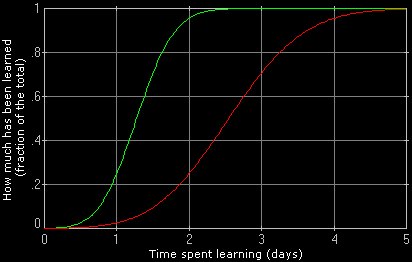
|
|
But then, a sentence "using this camera is hard to learn" does not sound as professional as "this camera involves a steep learning curve", even if it reflects what the writer meant.
| |
|
Another new article: Noise Filtering, Sharpness, and high ISOs in the E-3; the title should be self-explanatory. The piece includes more than 150 samples comparing the results at various combinations of these three factors. More E-3 stuff coming this weekend.
Having found some spare time to process the gathered data, I can now present the results of my E-3 image stabilization test. Using the procedure originally developed for the E-510, I've checked the new camera at focal lengths of 12, 60, and 150 mm. The IS advantage turned out to be A few minor updates to the E-3 review, to account for the IS test results, and to clarify the situation with camera's weatherproofing. The full Olympus E-3 review has been posted, and the First Look updated. The next step will be Part 2 of the samples, and a report on noise filtering and image sharpening in this camera; I hope to have one of those by the next weekend. New (?) Sigma lenses. Sigma just announced the pending release of two more lenses in the Four Thirds mount: the 10-20 mm F/4-5.6 EX DC HSM and the 70-200 mm F/2.8 Apo II EX DG Macro HSM (these names read like those of Spanish aristocracy from a few hundred years ago!). The first one will become the second-widest rectilinear zoom for Olympus SLRs (after the excellent, and quite costly, 7-14 mm ZD), while the second seems to be a direct competitor to the newly-available 50-200 mm F/2.8-3.5 ZD ED SWD by Olympus. Note that "DG" in a Sigma lens name means that this is actually a full-frame 35-mm film design, adapted to digital format (mostly by somewhat improved multicoating), while "DC" denotes a digital-specific design, covering only (and optimized for) the APS-C frame, just a tad bigger than the Four Thirds one. A rough guess is that DG lenses of focal lengths above 50 mm or so may be good enough for the higher resolutions required by the smaller digital image, but doubts remain about wider DG designs, which were optimized for an entirely different purpose; at shorter focal lengths I would trust only DC lenses. This was one of the reasons my Four Thirds lens list had to be updated (plus some cleanup and new links to manufacturers' data). At present the list includes thirty "current" lenses, plus four to be released (including these two), and four more replaced with newer ones. More "progress" on the xD-Picture front? Olympus issued a quite hilarious press release announcing the new xD-Picture "M+" type card. The new type will be about 50% slower than the "H" type (pulled off the market last year for no known reason), and capacities are expected up to 2 GB (the "H" type announcement of 2006 was promising sizes up to 8 GB). What is so hilarious, is that the press release presents this an as achievement. Seriously, the xD format should be long ago put out of its misery. All it offers is higher profit margins. My card-writing tests with the E-3 show that an xD "H" card is about three times slower than a SanDisk Extreme IV, a quite unimpressive performance. One of the reasons is that the xD design (at least for the "M" type) is based on multi-level memory cells (where one cell stores not one bit of information as two different states, but two bits as four states); slower and more error-prone, but cheaper than the two-level solution. Interestingly, you can also find multi-level Compact Flash cards; a 4 GB card of that type costs about a third of the price of a two-level card from the same manufacturer (Transcend) — less than twenty dollars (which is still a bargain, if you accept the caveats). The full E-3 review is steadily progressing; about 50% of text is done, plus most illustrations and samples. Perhaps another week before it becomes presentable. In the meantime, read the huge and informative E-3 on Test article by my British friend, John Foster, posted on his site. In any case, a man should have at least two things in life: a beautiful and caring wife, and a good, all-purpose lens. The first I already have; now I only need to get the 12-60 mm ZD. The first batch of E-3 image samples is ready online. Some of them were shot, within minutes and from the same vantage point, with the two upscale "kit" lenses offered by Olympus: the older 14-54 mm F/2.8-3.5 ZD, and the newer 12-60 mm F/2.8-4.0 ZD. I have no doubt now that the new lens consistently outperforms the older one (which is already so good!), especially off-center, in spite of having a wider zoom range. Another question is whether this difference will be visible in less than 1:1 pixel scale, e.g., in reasonably-sized (12×16" or 30×40 cm) prints. If in doubt, feel free to grab some of my full-frame images posted in that article, print them (or have them printed online if a larger size is what you need), and then decide for yourself if the improvement (in addition to the extra 2 mm at the short end) is worth an extra $500. My Four Thirds DoF tables have been recomputed (easy, as I wrote a program which generates a formatted HTML page with results), to include a number of new focal lengths; most notably 7 and 12 mm. I still have a ton of E-3 stuff to push out of the shop, so watch this space. In the meantime, my email backlog shrunk to less than two weeks; maybe this is not a losing battle? C-5060WZ users: the updated mode dial article now contains a PDF article, written by a German reader, on how you can fix the infamous problem itself, without paying Olympus $200 or more for repair. This camera has still lots of life left in it. Can you imagine that it still goes at the asking price between $350 and $650? Why did Olympus pull the plug on this line? | |
|
Olympus E-3: The First (and Second) Look has just been posted, if in an early, draft version. This has been (and still is) a very busy time; so far I've shot about 1500 frames with this camera, and I think I've got some idea about it; enough to share with you. The samples, at least basic ones, are also ready for formatting and a second-look scrutiny; this will take a few more days. I'm also planning at least four more related pieces: a full, detailed review, a piece on the suspected front-focus problem (already briefly discussed in the posted article), a quantitative analysis of image stabilization, and a comparison of noise reduction versus sharpening setting combinations. At least these are the pieces for which I've already collected the raw material, and which await only analysis and write-up. Only? Remember that I can work on this only on evenings and weekends, having a full-time job in a company suffering from shortage of cheap labor. Kindness of strangers: In addition to Don, whose E-3 I'm torturing now, two other Readers offered me the use of their E-3's for the same purpose. For that I feel grateful, and flattered. (Thanks also for the collection initiative, you know who you are, but this I couldn't accept for a number of reasons. Still, same feeling.) Firmware updates: Both the E-3 and E-1 received new firmware versions yesterday. In both cases, the most visible change is allowing for use of image stabilization with legacy (i.e., non-Four-Thirds) lenses, and some users seem to be ecstatic. I've also dragged outside the E-3, and later, the E-510, equipped with a four-pound (more exactly: 1.7 kg) 300 mm Zeiss Sonnar, to see how this works, but no conclusion yet; at 1/150 s I've got all samples almost equally sharp — or rather unsharp, because of focus problems. Oh, well, I'll do better next time, soon. I might have been the only person who complained (at least publicly) about the misbehavior of the live histogram function in the E-510 under low light conditions. Lo and behold, the new firmware fixed the problem; the histogram seems to behave in a predictable fashion. (It is still acting up with Live View Boost enabled, but this I can, at least, understand and ignore: just don't use the boost.) I don't even know if the E-3 suffered from the same problem, as I was only planning to check that; with the current firmware it seems to be OK (with the same caveat). This fix is not even mentioned by Olympus, at least not in the U.S. Well, one day Olympus may even consider an option to upgrade the firmware without going thorough the Olympus Master or Studio, which would be very right thing to do. Let's not abandon hopes. At lest this time I was able to get to their server on the first attempt... It is after 3 AM; some sleep would be nice... Back in Maryland, after a long and lazy Christmas break in Poland. Happy New Year! My new Asus U6S laptop is performing nicely, thank you: it runs my air traffic applications 30% faster than my desktop computer, which uses an Athlon XP 3000+ processor from just a few years ago. And these applications do not even take any advantage of two processor cores! Being able to turn off most of the Vista "improvements" (shadow copy, quick search/indexing, and User Account Control to start with), I can use it almost as I've used Windows XP, if with a few irritating quirks and sporadic loss of wireless connectivity for no apparent reason: some days not at all, and some days every few minutes. I'm catching up with the email backlog, now handling messages from December. I'm responding to all legitimate emails, even those asking "How can you claim that a cheap plastic E-510 with a tunnel vision viewfinder and highlight clipping can compete with ***" (fill in your favorite brand here), although with this kind I'm slowly losing patience. | |
|
The E-3 is the subject of many emails I'm receiving: will I put this camera through its paces, and if, when will the write-up be posted? With no more than a brief session with the camera, I wasn't planning to do that; then a fellow photographer living nearby kindly offered to let me use his E-3 with the 12-60 mm F/2.8-4.0 ZD lens for a couple of weeks. Could I refuse that? (Thank you, Don!)
Here I'm braving the sub-freezing temperatures today, shooting some comparative samples against the E-510 with the 14-54 mm ZD lens. No, I'm not sharing any impressions yet; expect a first draft in a week or so... (Photo by Ann Lipinski: Olympus E-410, program exposure at ISO 100; tonally adjusted and strongly cropped.) |
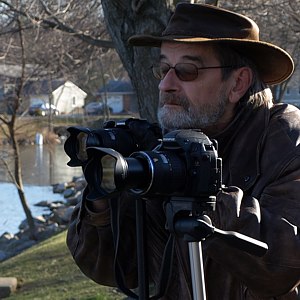
|
|
Don is also an experienced photographer and a master printer/framer; he treated me to some of his Kodalith prints of Maryland landmarks, shot about forty years ago, and impressed the you-know-what out of me; the best collection of Maryland historic photos I've ever seen. Currently he is using an E-1, E-330, E-510 and an E-3 (not for a while!), and his results are as good as mine will be in 10-12 years — if I work really hard. Stay tuned, this is not the last time you've heard of the man... On the software front, I've decided to part with another $90, and upgraded to the new version of the ACDSee Pro. I've been living with earlier versions of this image management software since mid-Nineties, and, as much as I'm complaining about it, I keep coming back. (Yes, I've tried hard to like the Adobe Lightroom and some other similar applications, to no avail.) ACDSee is still the most responsive image browser/cataloger I've tried, more capable than the free Irfan View, and faster than the Fast Stone. (The latter is quite polished and capable, but a bit slow and limited; still a good choice if you are on a budget and willing to click through donation requests. I'll be watching this application closely.) The good news about the new ACDSee is that it includes raw development for the Olympus ORF format. While I rarely resort to saving raw images, some people may find this of interest, especially that the feature seems to be nicely implemented, and with a wide range of adjustments. | |
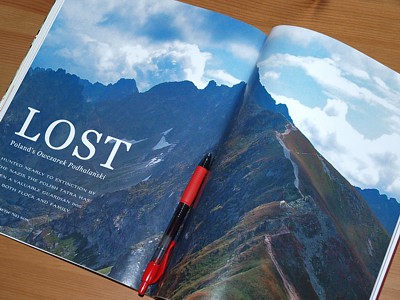
|
Just for the bragging rights: I forgot to mention that one of my pictures ended up as a two-page spread in the Wild Fibers magazine ("wool around the world"), illustrating a piece on the Polish Shepherd dog. This is a picture of Mt. Swinica in the Tatra mountains, shown in my Tatra gallery. It was shot back in 2000 with my first usable digital camera, the three-megapixel Olympus C-3000Z (which is still serving a friend).
(The photo of the magazine: Olympus E-3 with the 12-60 mm ZD lens, built-in flash, aperture priority.) |
|
Another Quest article, Leica M8: An Instant Classic — even if the M8 did not become an overnight hit, it might have affected digital camera development in more than one way. Have a look. | |
 |
 |
 |
 |
 |
 |
 |
| Home: wrotniak.net | Search this site | Change font size |
| Posted 2006/01/30; last updated 2008/12/29 | Copyright © 2006-2008 by J. Andrzej Wrotniak |